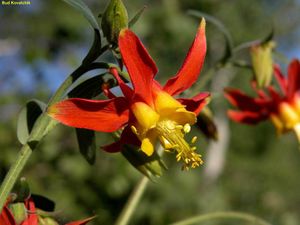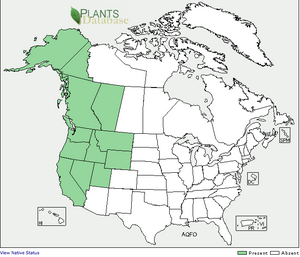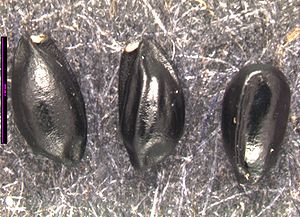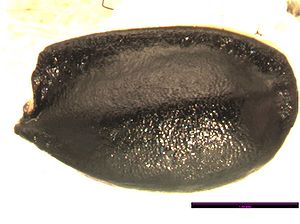Aquilegia formosa
- Scientific Name: Aquilegia formosa
- Family: Ranunculaceae
- Common Names: red columbine, Sitka columbine
- Codon: AQUFOR
Contents
Taxonomy
| Scientific classification | |
|---|---|
| Kingdom: | Plantae |
| Subkingdom: | Viridiplantae |
| Phylum: | Tracheophyta |
| Subphylum: | Spermatophytina |
| Class: | Magnoliopsida |
| Subclass: | Ranunculanae |
| Order: | Ranunculales |
| Family: | Ranunculaceae |
| Genus: | Aquilegia L. |
| Species: | Aquilegia formosa Fisch. Ex DC. |
| Synonyms | |
| |
Description
Perennial herb growing from a simple to branched woody base with several stems, to 10 dm. tall.[3] Long petiolate, mostly basal leaves to 5.5 cm long.[3] Red flowers usually several, nodding; sepals 5, petal-like, short-clawed; petals 5, yellow, red-spurred at base;[4] stamens numerous, the inner ones sterile.[3] Follicles 5.[4]
Bloom Period
May-August [3]
Distribution
Widely distributed throughout Washington; Alaska south to California, coastal and inland to the Rocky Mountains. [3]
Habitat
Open woods, lowlands to mid-elevation. [3]
Uses
Western columbine is a pollinator food source and thus can be used in site rehabilitation. It also attracts hummingbirds, browsing and grazing animals.[5] Western First Nations have used A. formosa for many purposes, including the treatment of coughs, stomach aches and diarrhea.[6]
Propagation
Follicles normally dry and split open at maturity. Gently crush dried seed heads to release remaining seeds; cleaned with "office clipper" air-screen. The papery, light pod chaff is easily separated from seed. Fairly long moist pre-chill improved germination; seeded cones stored for 6 months in a cold walk-in cooler with soil surface kept moist, produced more than 15% germination. Germination tests at Oregon State University seed lab were reported at just 8% with a 3-day prechill treatment. 3 to 5 seeds each were sown into Ray-leach SC-10 super cells filled with Fisons' Sunshine #1 potting mix, amended with 3-month slow-release Osmocote NPK fertilizer and small amounts of Micromax trace elements. Cones were well-watered and placed in to a walk-in cooler at 40 F for 6 months cold-stratification. Cones were moved outdoors to shadehouse in mid-spring to germinate. Initial germination is spotty, and initial growth is quite slow. Seedlings need light but fairly frequent watering to keep soil moist but not soggy.[7]
Seed
Seed sample from: 2011
Average Measurement: 2.5 x 1.4 x 1.2
Measurement Range: L: 2.5 - 2.75, W: 1.2 - 1.5, D: 1 - 1.5
Features
Shape: Seeds tapering at hilum end, broadening at opposite side.
Color: Hilum is white, seed is black.
Surface: At least one distinct ridge runs from the hilum to the opposite side. End opposite hilum is sometimes puckered or having concave pits. Seed is glossy and lightly textured with very small bumps.
Latitudinal Cross Section: elliptical ![]()
Longitudinal Cross Section: obovate ![]()
Basic Explanations and Assumptions:
The dimensions for the seeds are length x width x depth. The location of the hilum is used as the base of the seed, and the length is measured from hilum to the opposite apex. Where a style is present, the length is measured from the hilum to the bottom of the style. Width is measured at a right angle to the length at the widest part. Depth is measured at a right angle to the intersection of height and width lines.
Measurements included are the mean average for each measurement of ten separate seeds.
All measurements in millimeters unless otherwise noted.
Photo Gallery
References
- ↑ Washington Flora Checklist
- ↑ Integrated Taxonomic Information System. Retrieved from https://www.itis.gov/servlet/SingleRpt/SingleRpt
- ↑ 3.0 3.1 3.2 3.3 3.4 3.5 WTU Herbarium, Burke Museum, & University of Washington. Retrieved from http://biology.burke.washington.edu/herbarium/imagecollection/taxon.php?Taxon=Aquilegia%20formosa
- ↑ 4.0 4.1 Hitchcock, C. L., Cronquist, A., Giblin, D., & Legler, B. et al. (2018). Flora of the Pacific Northwest: an illustrated manual. Seattle: University of Washington Press. p. 86.
- ↑ Goodrich, A. (2012). Guidelines for Establishment of Seed Production Sites on Military Installations. Department of Defense Legacy Resource Management Program. Retrieved from https://denix.osd.mil/nr/focus-areas/habitat/habitat-restoration/reports/guidelines-of-establishment-of-seed-production-sites-on-military-installations-final-report-february-2012-legacy-10-326/
- ↑ Native American Ethnobotany Database. Retrieved from http://naeb.brit.org/uses/search/?string=aquilegia+formosa
- ↑ Native Plant Network Propagation Protocol Database. Retrieved from https://npn.rngr.net/renderNPNProtocolDetails?selectedProtocolIds=ranunculaceae-aquilegia-2362







